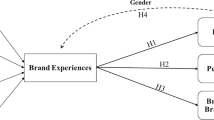Abstract
Marketing academics and practitioners have acknowledged that consumers look for brands that provide them with unique and memorable experiences. As a result, the concept of brand experience has become of great interest to marketers. The present field study, conducted with actual consumers, addresses the question whether different consumers prefer different experiential appeals and whether experiential types moderate the relationships between brand attitude and purchase intention. We find that there are five types of consumers: hedonistic, action-oriented, holistic, inner-directed, and utilitarian consumers. Moreover, the relationship between attitudes and intentions is strongest for holistic consumers and weakest for utilitarian consumers.
Similar content being viewed by others
References
Schmitt, B.H. (1999) Experiential Marketing: How to Get Customers to Sense, Feel, Think, Act, Relate to Your Company and Brands. New York: The Free Press.
Pine II, J.B. and Gilmore, J.H. (1999) The Experience Economy: Work is Theatre and Every Business a Stage. Cambridge, MA: Harvard Business School Press.
Schmitt, B.H. and Rogers, D.L. (eds.) (2008) Handbook on Brand and Experience Management. Cheltenham, UK and Northampton, MA: Edward Elgar.
Smith, S. and Milligan, A. (2002) Uncommon Practice: People Who Deliver a Great Brand Experience. Cambridge, UK: Pearson Education.
Lindstrom, M. (2005) Brand Sense: Build Powerful Brands through Touch, Taste, Smell, Sight, and Sound. New York: The Free Press.
Gobé, M. (2001) Emotional Branding: The New Paradigm for Connecting Brands to People. New York: Allworth Press.
Morrison, S. and Crane, F. (2007) Building the service brand by creating and managing an emotional brand experience. Journal of Brand Management 14 (5): 410–421.
Holbrook, M.B. and Hirschman, E.C. (1982) The experiential aspects of consumption: consumer fantasies, feelings, and fun. Journal of Consumer Research 9 (2): 132–140.
Hoch, S.J. (2002) Product experience is seductive. Journal of Consumer Research 29 (3): 448–454.
Joy, A. and Sherry Jr, J.F. (2003) Speaking of art as embodied imagination: A multisensory approach to understanding aesthetic experience. Journal of Consumer Research 30 (2): 259–282.
Hui, M.K. and Bateson, J.E.G. (1991) Perceived control and the effects of crowding and consumer choice on the service experience. Journal of Consumer Research 18 (2): 174–184.
Kerin, R.A., Ambuj, J. and Howard, D.J. (1992) Store shopping experience and consumer price-quality-value perceptions. Journal of Retailing 68 (4): 376–397.
Ryder, I. (2007) Customer experience. Journal of Brand Management 15 (2): 85–88.
Brakus, J.J., Schmitt, B.H. and Zarantonello, L. (2009) Brand experience: What is it? How do we measure it? And does it affect loyalty? Journal of Marketing 73 (3): 52–68.
Oliver, R.L. (1997) Satisfaction: A Behavioral Perspective on the Consumer. Boston, MA: McGraw-Hill.
Reicheld, F. (1996) The Loyalty Effect: The Hidden Force Behind Growth, Profits, and Lasting Value. Boston, MA: Harvard Business School Press.
Mitchell, A.A. and Olson, J.C. (1981) Are product attribute beliefs the only mediator of advertising effects on brand attitude? Journal of Marketing Research 18 (3): 318–332.
Cf. Brown, S.P. and Stayman, D.M. (1992) Antecedents and consequences of attitude toward the ad: A meta-analysis. Journal of Consumer Research 19 (1): 34–51.
Chandon, P., Wansink, B. and Laurent, G. (2000) A benefit congruency framework of sales promotion effectiveness. Journal of Marketing 64 (4): 65–81.
Chen, Q. and Wells, W.D. (1999) Attitude toward the site. Journal of Advertising Research 39 (5): 27–37.
Webb, D.J., Green, C.L. and Brashear, T.G. (2000) Development and validation of scales to measures attitudes influencing monetary donations to charitable organizations. Journal of the Academy of Marketing Science 28 (2): 299–309.
Nebenzahl, I.D. and Secunda, E. (1993) Consumers’ attitudes toward product placement in movies. International Journal of Advertising 12 (1): 1–12.
Youn, S. and Kim, H. (2008) Antecedents of consumer attitudes toward cause-related marketing. Journal of Advertising Research 48 (1): 123–137.
Spears, N. and Singh, S.N. (2004) Measuring attitude toward the brand and purchase intentions. Journal of Current Issues & Research in Advertising 26 (2): 53–66.
Fishbein, M. and Ajzen, I. (1975) Belief, Attitudes, Intention and Behavior: An Introduction to Theory and Research. Reading, MA: Addison-Wesley.
Bagozzi, R.P. (1981) Attitudes, intentions, and behavior: A test of some key hypotheses. Journal of Personality and Social Psychology 41 (4): 607–627.
Mathwick, C. (2005) The effect of playful web experiences on brand attitude formation. Advances in Consumer Research 32 (1): 65.
Yoo, C. and MacInnis, D. (2005) The brand attitude formation process of emotional and informational ads. Journal of Business Research 58 (10): 1397–1406.
Keller, K.L. (1993) Conceptualizing, measuring, managing customer-based brand equity. Journal of Marketing 57 (1): 1–22.
Bruner II, G.C., Hensel, P.J. and James, K.E. (2001) Marketing Scales Handbook: A Compilation of Multi-Item Measures for Consumer Behavior & Advertising – Vol. IV. Mason, OH: Thompson.
See Hair Jr, J.F., Black, W.C., Babin, B.J., Anderson, R.E. and Tatham, R.L. (2005) Multivariate Data Analysis, 6th edn. Upper Saddle River, NJ: Pearson Prentice-Hall.
See Rodríguez Santos, C., Cervantes Blanco, M. and González Fernández, A. (2006) Segmenting wine consumers according to their involvement with appellations of origin. Brand Management 13 (4/5): 300–312.
Babin, B.J., Darden, W.R. and Griffin, M. (1994) Work and/or fun: Measuring hedonic and utilitarian shopping value. Journal of Consumer Research 20 (4): 644–656.
Author information
Authors and Affiliations
Corresponding author
Rights and permissions
About this article
Cite this article
Zarantonello, L., Schmitt, B. Using the brand experience scale to profile consumers and predict consumer behaviour. J Brand Manag 17, 532–540 (2010). https://doi.org/10.1057/bm.2010.4
Received:
Revised:
Published:
Issue Date:
DOI: https://doi.org/10.1057/bm.2010.4




